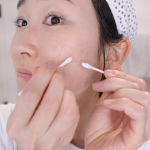Exfoliation is a vital step in any skincare routine, helping to remove dead skin cells, unclog pores, and reveal a brighter, smoother complexion. Regular exfoliation can improve skin texture, promote cell turnover, and enhance the effectiveness of other skincare products. However, understanding the right methods and frequency for exfoliation is crucial to avoid overdoing it and causing irritation. This article explores the importance of exfoliation, explaining how to incorporate it effectively into your routine, and how often you should exfoliate to achieve healthy, glowing skin.
What Exfoliation Is and How to Do It Properly
Exfoliation involves removing dead skin cells from the surface of your skin to promote a healthier, more radiant complexion. There are two main types of exfoliation: physical and chemical. Physical exfoliation uses scrubs or brushes to manually slough off dead skin, while chemical exfoliation employs acids or enzymes to dissolve them. Both methods can be effective, but the choice depends on your skin type and sensitivity. It’s important to choose the right exfoliator and use it gently to avoid damaging your skin.
Where and when you exfoliate matters. Exfoliation should be done on clean, damp skin to minimize irritation. For most skin types, exfoliating two to three times a week is sufficient, though this can vary based on individual needs. Those with sensitive skin might benefit from less frequent exfoliation, while those with oily or acne-prone skin may need more. Always follow up with a moisturizer to hydrate and soothe the skin, ensuring it remains balanced and healthy. Incorporating exfoliation into your routine correctly can make a significant difference in your skin’s appearance.
1. Choosing the Right Exfoliator
Selecting the appropriate exfoliator is key to achieving the best results. For those with sensitive or dry skin, a gentle chemical exfoliant like lactic acid or an enzyme-based product is ideal. These exfoliants work by dissolving dead skin cells without the harsh scrubbing that can irritate delicate skin. On the other hand, those with oily or combination skin might benefit from a salicylic acid-based exfoliant, which penetrates deep into pores to remove excess oil and prevent breakouts. Understanding your skin type is crucial for choosing the right product.
Additionally, consider your skin’s condition and any concerns you may have. For instance, if you struggle with hyperpigmentation or uneven texture, a chemical exfoliant containing glycolic acid can help brighten and smooth your skin. If you prefer physical exfoliants, opt for products with fine, non-abrasive particles to minimize the risk of micro-tears. Always patch-test new products to ensure they are suitable for your skin. By carefully selecting an exfoliator that aligns with your skin’s needs, you can achieve a clear, radiant complexion without causing harm.
2. When and How Often to Exfoliate
Determining the right frequency for exfoliation is essential for maintaining skin health. Over-exfoliating can lead to irritation, redness, and sensitivity, while under-exfoliating might leave your skin looking dull and clogged. Generally, two to three times a week is a good starting point for most people. However, your skin type and the exfoliant you use will influence how often you should exfoliate. For example, sensitive skin may only require exfoliation once a week, while oilier skin types might benefit from more frequent exfoliation.
Timing also plays a role in effective exfoliation. Exfoliating in the evening allows your skin to repair itself overnight, free from environmental stressors like UV rays and pollution. Always follow exfoliation with a hydrating serum or moisturizer to replenish moisture and support your skin’s barrier. If you exfoliate in the morning, don’t forget to apply sunscreen to protect your newly revealed skin from sun damage. Establishing the right exfoliation schedule ensures that your skin remains healthy, smooth, and glowing, without the risk of overdoing it.
Where to Exfoliate and How to Integrate It Into Your Routine
Exfoliation should be integrated into both your face and body skincare routines. While facial exfoliation often receives the most attention, body exfoliation is equally important for maintaining smooth, healthy skin. Areas prone to dryness, such as elbows, knees, and heels, can benefit from regular exfoliation to remove dead skin and prevent rough patches. Use a gentle scrub or a chemical exfoliant designed for the body, focusing on these areas to keep your skin soft and even-toned.
Incorporating exfoliation into your routine doesn’t have to be complicated. Simply add it to your cleansing step, either in the morning or evening, depending on your schedule and preference. Start with a clean face or body, apply your chosen exfoliant, and follow the product instructions. After exfoliating, always moisturize to lock in hydration and protect your skin’s barrier. By making exfoliation a regular part of your routine, you can enjoy smoother, brighter skin from head to toe, with minimal effort.
The Right Approach to Exfoliation for Healthy Skin
Exfoliation is a powerful tool in maintaining healthy, radiant skin, but it must be approached with care. By choosing the right exfoliator for your skin type and incorporating it into your routine at the appropriate frequency, you can achieve glowing results without irritation. Remember, less is often more when it comes to exfoliation; overdoing it can compromise your skin’s barrier. A balanced approach, combining regular exfoliation with proper hydration, will leave your skin looking smooth, fresh, and vibrant.
Understanding the importance of exfoliation and how to do it correctly is key to maximizing its benefits. Whether you’re targeting clogged pores, uneven texture, or simply want a brighter complexion, exfoliation can help. However, it’s essential to listen to your skin and adjust your routine as needed. By prioritizing gentle, effective exfoliation, you can maintain a healthy glow that enhances your natural beauty, ensuring your skin remains at its best no matter your age or skin type.








